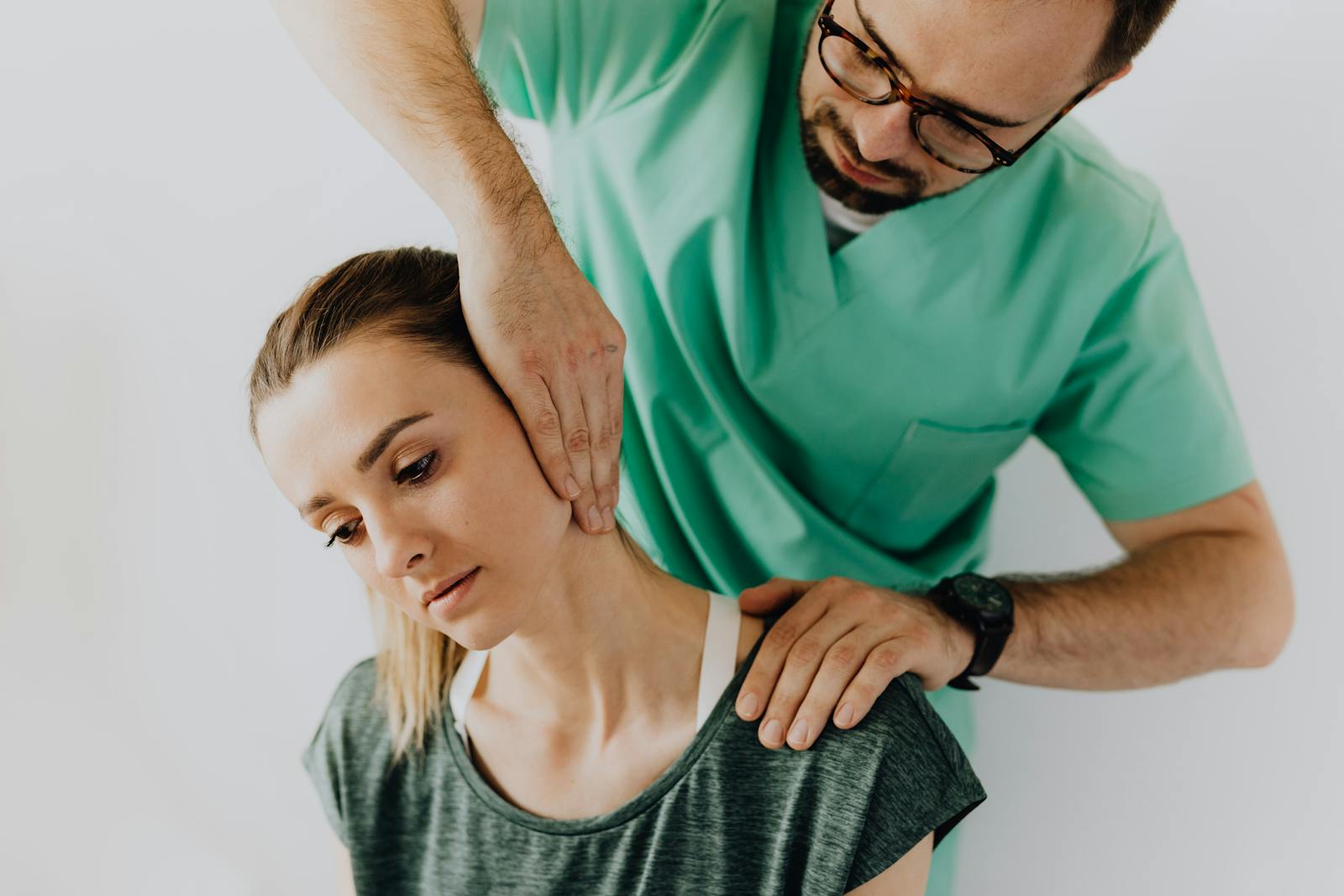The act of neck cracking, an audible pop experienced during a swift movement of the spinal column in the neck, is a topic of significant debate within the medical community. For some, it offers a prompt release from tension and discomfort, while others voice concerns over potential harm and injury that could be caused. However, the true implications of this seemingly innocuous habit remain shrouded in mystery, warranting further exploration into the physiological underpinnings, possible benefits, and potential risks. As we investigate this contentious issue, we invite you to ponder: is neck cracking relieving or risky?
Understanding the Phenomenon of Neck Cracking
A significant number of individuals experience the phenomenon of neck cracking, a common auditory event that often arises from the intentional or unintentional manipulation of the cervical spine. This prevalent occurrence, often described as a popping or grinding sound, tends to evoke a wide range of reactions, from relief and satisfaction to discomfort and concern.
In certain cases, the act of neck cracking shifts from a sporadic occurrence to a habitual practice, leading to a phenomenon known as ‘cracking addiction’. This term refers to the compulsion to routinely crack one’s neck, driven by a perceived need for relief or satisfaction. It is important to note that while this practice may provide temporary satisfaction, it could also potentially worsen underlying neck issues or instigate new ones.
Cultural practices also play a significant role in understanding the phenomenon of neck cracking. In various societies, neck cracking is seen as a form of self-adjustment or self-manipulation, akin to a form of chiropractic care. Despite the potential risks associated with the act, it has been ingrained in many cultures as a means to alleviate tension or discomfort in the neck region. However, health professionals often advise against habitual neck cracking due to the potential for injury.
The Anatomy of Your Neck
To fully comprehend the implications of neck cracking, an understanding of the underlying neck structure is essential. The neck, medically known as the cervical spine, is a complex network of bones, muscles, nerves, and vessels. Its primary functions include supporting the skull, enabling head movements, and safeguarding the spinal cord, making its role vital to overall body mobility and function.
Understanding Neck Structure
Diving into the intricate world of neck anatomy, we find a sophisticated network of muscles, bones, nerves, and vessels that support our heads and enable us to move. The cervical spine, a critical component of this structure, is comprised of seven small vertebrae beginning at the base of the skull. Its health is crucial to overall neck function and flexibility. Understanding the importance of neck stretching is essential for maintaining cervical spine health. Regular stretching helps keep these muscles flexible and strong, which in turn supports the spine and prevents injury. The neck’s sophistication and delicacy highlight the need for proper care and understanding. Appreciating this complex structure aids in fostering practices that promote excellent neck health.
Implications of Neck Movement
Having appreciated the complexity and fragility of the neck’s structure, we now turn our attention to the implications of neck movement, exploring in detail how the anatomy of your neck influences its function and mobility. Neck mobility is greatly influenced by the intricate network of muscles, ligaments, and vertebrae that comprise the neck. A well-aligned neck supports fluid movement and reduces strain on these structures. Conversely, poor alignment, often due to incorrect posture, can lead to discomfort and limited mobility. Posture correction is an essential element in maintaining excellent neck mobility. By ensuring correct posture, the forces exerted on the neck are evenly distributed, reducing the risk of injury and enhancing overall neck health.
What’s That Popping Sound?
When one experiences a popping sound during neck cracking, it is typically due to the rapid release of gas bubbles trapped in the joints. This occurrence, often surrounded by Popping Myths and misinterpretations, has a vital explanation rooted in the biology of our bodies.
The Sound Origins can be explained by the following three points:
- Synovial Fluid: Our joints are lubricated by a substance called synovial fluid. This fluid contains dissolved gases like oxygen, nitrogen, and carbon dioxide.
- Bubble Formation: When the joint tissues are stretched during a crack, the pressure within the joint decreases. This change in pressure allows the gases to come out of the solution, forming bubbles.
- Rapid Release: The popping sound we hear is the rapid release and collapse of these gas bubbles in the synovial fluid.
It’s important to understand that the distinctive noise is not an indication of any damage being inflicted on the joints. Instead, it’s merely the physiological response of the body to a sudden change in joint pressure. This understanding can help dispel common misconceptions associated with the cracking or popping sound heard during neck adjustments.
The Science Behind Neck Cracking
To fully appreciate the intricacy of neck cracking, it is essential to explore the physiological processes and biomechanical forces at play during this common, yet frequently misunderstood, phenomenon. The distinct popping sound associated with neck cracking is attributed to a process called cavitation. During cavitation, a rapid change in joint pressure causes gas bubbles within the synovial fluid to collapse, resulting in the significant noise.
From a chiropractic perspective, the mechanics of neck cracking are often utilized for therapeutic purposes. However, some people develop a ‘cracking addiction’, where they repeatedly seek the temporary relief and satisfaction that neck cracking can provide. This compulsive behavior is not without risks, as excessive neck cracking may potentially lead to joint damage and other health issues.
In-depth understanding of the science behind neck cracking can help individuals make informed decisions about their health. While occasional self-cracking is generally harmless, it is advisable to consult with a healthcare professional, such as a chiropractor, for any persistent discomfort or urge to crack the neck. This is especially important given the vital nature of the cervical spine, which houses crucial nerves and blood vessels.
Potential Benefits of Neck Cracking
Despite the potential risks associated with frequent neck cracking, several notable benefits have been identified, particularly when performed by a trained professional.
From a chiropractic perspective, neck cracking, or cervical spine manipulation, can potentially yield several positive results. Some of these benefits are:
- Relief from Neck Pain and Stiffness: Cracking can relieve pressure on the neck muscles, which can reduce pain and stiffness. It can also increase the range of movement, making the neck more flexible and less prone to injuries.
- Stimulation of Nerve Function: Chiropractic neck cracking can stimulate nerve function, improving the overall performance of the nervous system. This can lead to enhanced body function and better overall health.
- Release of Endorphins: The cracking process often induces the release of endorphins, the body’s natural ‘feel-good’ hormones. This can help to reduce stress and promote a sense of well-being.
But, it’s essential to understand that neck cracking can turn into a ‘crack addiction’, where the person feels a constant need to crack their neck. And while the immediate benefits can be appealing, one must consider the long-term effects and potential risks, which we will discuss in the next section.
The Risks Associated With Neck Cracking
While neck cracking may provide temporary relief to some, it is imperative to contemplate the associated risks. This includes potential physical damages, neurological risks, and psychological implications. A thorough understanding of these dangers is vital for individuals considering or currently engaging in the practice of neck cracking.
Potential Physical Damages
Although neck cracking might offer temporary relief to some, it carries with it a range of potential physical damages that could pose significant risks to one’s health. The habit of neck cracking can lead to an addiction, where a person feels a constant need to crack their neck, potentially exacerbating the risk of physical damage.
- Cracking Addiction: An urge to continually crack the neck can lead to overstretching of ligaments, making the neck unstable and prone to injury.
- Posture Effects: Chronic neck cracking can cause changes in posture, leading to an imbalance in the body’s alignment and further musculoskeletal issues.
- Arthritis: Regular neck cracking can speed up the process of wear and tear in the joints, increasing the risk of developing osteoarthritis.
Neurological Risks Explored
Beyond the physical damages, neck cracking also carries substantial neurological risks, warranting a more in-depth exploration. The stroke probability, for instance, increases due to the potential for arteries in the neck to become compromised during the act. This can lead to blood clots, thereby greatly increasing the risk of stroke.
Chiropractic perspectives have also shed light on these risks, with professionals cautioning against the unregulated practice of neck cracking, arguing that it can cause nerve irritation and potentially even damage to the spinal cord. It’s crucial to highlight that while these risks may seem concerning, they are relatively rare. However, the severity of potential outcomes necessitates informed decisions about engaging in habitual neck cracking. The neurological risks, though not fully understood, are not to be underestimated.
Psychological Implications Examined
In addition to the physical and neurological risks, the act of neck cracking also carries significant psychological implications that warrant careful examination. These implications primarily revolve around:
- Cracking Addiction: The relief experienced after cracking often leads to a repetitive cycle, developing into a compulsive behavior which can be classified as an addiction. Despite not being chemically addictive, the ‘need’ to crack can consume thoughts and actions, impacting daily life.
- Anxiety: Fear of potential harm or worsening symptoms can induce stress and anxiety, affecting mental well-being.
- Social Impact: Regular neck cracking can be socially off-putting, leading to isolation or negative perceptions by others.
The psychological impact of neck cracking, although often overlooked, is an important aspect to take into account in the broader discussion of its risks.
The Debate: Is Neck Cracking Healthy?
Often, the health implications of neck cracking spark a contentious debate among medical professionals. The concerns center around two main areas: the potential for cracking addiction and the cultural perspectives surrounding the practice.
From an addiction standpoint, some individuals develop a habitual need to crack their necks, often due to the temporary relief it provides from tension or discomfort. This repetitive behavior can lead to an unhealthy reliance, causing people to crack their necks excessively. It is argued that this could potentially lead to long-term damage, exacerbating neck pain and possibly contributing to joint issues.
Cultural perspectives also play a significant role in the debate. In some cultures, neck cracking, along with other forms of joint manipulation, is a widely accepted practice, believed to provide therapeutic benefits. However, in other societies, it is viewed skeptically due to concerns regarding its potential health risks.
It’s essential to note that while the temporary relief or cultural acceptance may make neck cracking seem harmless or even beneficial, the potential for injury or the development of a cracking addiction cannot be overlooked. Hence, the debate on whether neck cracking is healthy remains unresolved and complex.
Expert Opinions on Neck Cracking
While the debate on the health implications of neck cracking continues, various medical experts have provided their insights on the matter, shedding light on its potential benefits and risks.
- Chiropractic perspectives: Chiropractors often employ techniques that involve neck cracking. They assert that when conducted properly, this practice can alleviate tension, improve mobility, and promote overall spinal health. However, they caution against individuals attempting it without professional supervision due to potential risks.
- Medical standpoints: Many physicians express reservations about frequent neck cracking, citing concerns about possible damage to surrounding tissues, nerves, and blood vessels. They emphasize that, while it may provide temporary relief, it is not a long-term solution for conditions like chronic neck pain.
- Cultural beliefs: Cultural perspectives on neck cracking vary widely. In some societies, it is viewed as a harmless habit or a simple method of stress relief. In others, it is seen as potentially harmful and is discouraged.
Neck Cracking and Arthritis: Is There a Link?
Exploring the potential correlation between neck cracking and arthritis, scientific studies have yielded varying results, sparking further discussion in the medical community. Some research indicates that frequent neck cracking may increase the risk of developing osteoarthritis, while other studies suggest no definitive link. Most of these studies are observational and cannot prove causation.
Arthritis prevention strategies often include maintaining an active lifestyle, ensuring a healthy diet, and avoiding activities that put unnecessary strain on the joints, such as frequent neck cracking. These strategies aim to reduce the wear and tear on the joints, which is commonly associated with the onset of arthritis.
Non-pharmaceutical arthritis treatments also play a significant role in managing arthritis symptoms. This can include physical therapy, weight management, and the use of supportive devices. However, it’s worth noting that while these strategies can help manage symptoms, they cannot reverse arthritis once it has developed. Any potential risks associated with habits like neck cracking should be taken seriously.
Effective Alternatives to Neck Cracking
Considering the potential risks associated with neck cracking, it’s beneficial to discuss alternatives methods that can provide relief from neck discomfort or stiffness without adding undue stress to the joints. A growing interest in holistic approaches emphasizes the importance of treating the whole person, not just their symptoms.
- Chiropractic Alternatives: Chiropractors use hands-on spinal manipulation and other alternative treatments. The theory is that proper alignment of the body’s musculoskeletal structure, particularly the spine, will enable the body to heal itself without surgery or medication.
- Physical Therapy: Physical therapy often involves exercises to strengthen and stretch the neck muscles, which can alleviate stiffness and pain. Therapists may also use modalities like heat or cold therapy, or TENS (Transcutaneous Electrical Nerve Stimulation) to further alleviate discomfort.
- Mind-body Techniques: Practices like yoga, tai chi, and meditation can promote relaxation, ease muscle tension, and improve posture and alignment. These holistic approaches foster awareness of body mechanics and can help prevent neck discomfort and stiffness.
These alternatives to neck cracking are generally gentler on the body and carry fewer risks. They promote overall wellness while offering targeted relief for neck discomfort, providing a safer, more all-encompassing approach to neck health.
Tips for Safe Neck Cracking Practice
As we move on to the subtopic of ‘Tips for Safe Neck Cracking Practice’, it is crucial to grasp the correct techniques and the potential risks associated with improper procedures. This section will provide a detailed overview of appropriate methods to guarantee safety while practicing neck cracking. Additionally, we will explore the possible hazards of incorrect practice to emphasize the importance of maintaining caution during this practice.
Proper Neck Cracking Techniques
Mastering the art of safe neck cracking requires a vital understanding of proper techniques and precautionary measures. One must consider the following:
- Cracking Frequency: It is important not to overdo neck cracking. Limiting the frequency can prevent unnecessary strain and potential injury to the neck muscles and joints.
- Professional Guidance: Seek advice from a trained physiotherapist or chiropractor. They can provide the correct techniques and make sure that you’re not putting yourself at risk.
- Proper Positioning: Incorrect posture during neck cracking can lead to complications. Make sure you’re in a neutral, relaxed position.
Understanding and adhering to these techniques can aid in safe and effective neck cracking. Always remember, safety is paramount in any form of self-manipulation.
Risks of Incorrect Practice
Despite the perceived benefits of neck cracking, incorrect practice can pose significant risks and potentially lead to serious health complications. These risks can range from mild discomfort to severe neurological issues. One common problem is cracking addiction, where individuals feel a compulsive need to crack their necks, exacerbating the potential for injury. Frequent, unsupervised cracking can cause ligament damage, leading to instability in the neck.
In extreme cases, over-manipulation may result in vertebral artery dissection, a stroke risk. The chiropractic role is essential here, as professionals are trained to perform these manipulations safely and effectively. Hence, those seeking the relief that neck cracking can provide should consider professional consultation to mitigate these risks.
Frequently Asked Questions
How Frequently Should I Crack My Neck?
The frequency of such actions should be minimal due to potential risks. Regular exercise can enhance mobility, reducing the perceived need for habitual practices, which could otherwise become an unwanted ‘cracking addiction’. Consult a professional for advice.
Does Neck Cracking Affect My Overall Posture?
The impact of repetitive habits on overall posture can be significant. Specifically, habitual cracking may potentially influence spinal alignment, although further research is required to ascertain the long-term effects on postural health.
Can Neck Cracking Lead to Headaches or Migraines?
Yes, there’s a potential correlation between cracking and headaches or migraines. Such actions might irritate nerves in the neck, triggering pain responses that manifest as headaches or migraines. However, more research is needed for conclusive evidence.
Are There Specific Exercises to Prevent the Urge to Crack My Neck?
Yes, specific exercises can help prevent cracking urges. Psychology plays a role in habit formation and cessation. Exercises that promote strength, flexibility, and correct posture can effectively reduce the urge to crack.
Does Age Influence the Risk Factors Associated With Neck Cracking?
Yes, age can influence risk factors associated with certain habits. Age-related consequences and geriatric considerations can increase susceptibility to musculoskeletal injuries, making older individuals more prone to adverse effects from repetitive or strenuous activities.



